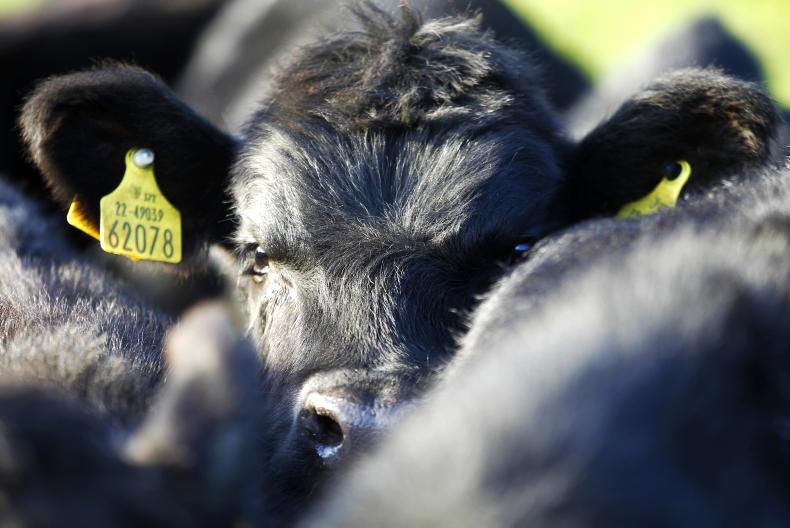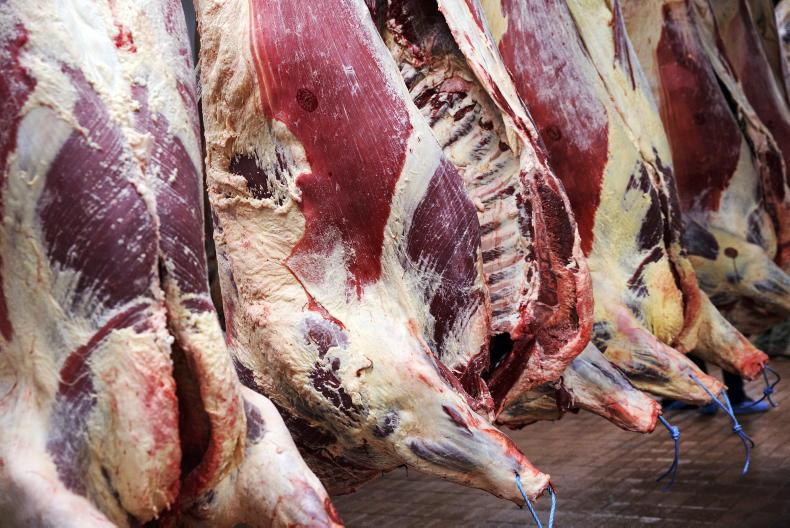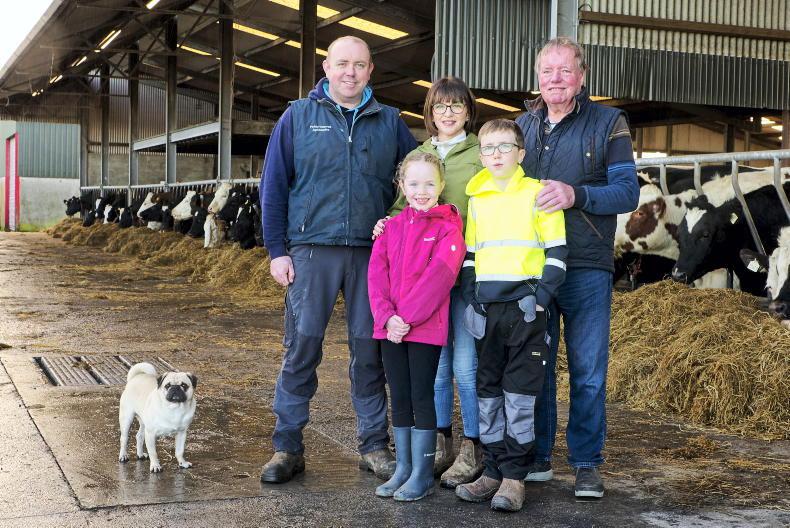The decline in the carcase weights and carcase conformation in the last number of years is an issue for beef finishers who are finding it harder and harder to finish dairy cross animals that leave a profitable margin.
Dairy farmers have been focused on calving ease and short gestation as the most important traits when selecting beef sires in the dairy herd.
Unfortunately, many of these bulls are negative for carcase weight and carcase conformation.
Figure 1 outlines the decline in carcase weight, carcase conformation and carcase fat cover over the past three years. Dairy beef calf registrations have increased by 275,000 since 2010 calf registration levels.
What is the dairy beef index?
The dairy beef index (DBI) is a breeding tool developed for Irish dairy and beef farmers to promote high-quality beef cattle bred from the dairy herd. The aim is that dairy farmers will use the index when selecting beef bulls to use on their dairy herd.
What are the benefits?
It will identify easy-calving and short-gestation beef bulls with high carcase merit.Progeny will be more saleable as calves and more profitable at slaughter.There will be minimal consequences on dairy cow fertility performance, milk production or health.What does the dairy beef index select for?
High € values for calving sub-index (64% of DBI):
Shorter gestation lengths.Easy calving.Less calf mortality.High € values for beef sub-index (36% of DBI)
Less feed consumption.High carcase weight and conformation.Low carcase fat.Meet factory spec for weight and conformation.Each €1 increase in dairy beef index can be interpreted as a €1 expected increase in profit for that bull’s progeny compared to progeny born to the average Holstein-Friesian bull.
Dairy farmers who are not keeping progeny may say “it’s not my problem” but that would be a short-term view to take. If dairy beef is unprofitable, beef farmers don’t buy calves and dairy farms are left with the problem. Calf welfare issues and questions over the sustainability of the current dairy breeding programme suddenly come into play.
How do we change it?
Similar to the EBI on the dairy side and the replacement index on the beef side, the dairy beef index aims to put an economic value on things such as calving difficulty, gestation length, carcase weight and carcase conformation.
Teagasc and ICBF have put a weighting on these values to make up the dairy beef index. The index was released on Monday 21 January and dairy farmers can now access the list at www.icbf.com and sort the list according to breed or any other trait. Figure 2 outlines the makeup of the index.
Table 1 profiles the top five bulls on the active bull list on the DBI and the top five bulls used on the dairy herd in 2018. If we take the average dairy beef index of the most used bulls at €43 and the average of the top five bulls on the DBI for 2019, there is a €57 difference.
This means that the progeny will be worth on average €57 more at slaughter. The most important aspect of this is that this gain can be achieved without any increase in calf mortality and minimal change on gestation length.
The next steps will be the rollout of the dairy beef index. It’s important that there is buy-in from the dairy industry and that the index is used to select beef bulls for the dairy herd.
One major issue is the level of sire identification in the dairy herd. At the moment, this is around 50%. In terms of harvesting maximum data from these bulls, this is below optimum and needs to improve if the dairy beef index is to get every chance to work.
The ideal would be that every calf gets DNA-tested at birth and the sire is available with 100% certainty for the beef farmer when purchasing calves.
If this was to roll out, the market may then dictate high prices for high-DBI-index calves and vice versa for low-index calves.
The big question is at the current cost of €22/head, who will pay for it?
If the dairy industry is serious about painting a positive picture around sustainability and calf welfare, this could be a small price to pay when you look at the negative issues around doing nothing and pretending the issue will go away.
The decline in the carcase weights and carcase conformation in the last number of years is an issue for beef finishers who are finding it harder and harder to finish dairy cross animals that leave a profitable margin.
Dairy farmers have been focused on calving ease and short gestation as the most important traits when selecting beef sires in the dairy herd.
Unfortunately, many of these bulls are negative for carcase weight and carcase conformation.
Figure 1 outlines the decline in carcase weight, carcase conformation and carcase fat cover over the past three years. Dairy beef calf registrations have increased by 275,000 since 2010 calf registration levels.
What is the dairy beef index?
The dairy beef index (DBI) is a breeding tool developed for Irish dairy and beef farmers to promote high-quality beef cattle bred from the dairy herd. The aim is that dairy farmers will use the index when selecting beef bulls to use on their dairy herd.
What are the benefits?
It will identify easy-calving and short-gestation beef bulls with high carcase merit.Progeny will be more saleable as calves and more profitable at slaughter.There will be minimal consequences on dairy cow fertility performance, milk production or health.What does the dairy beef index select for?
High € values for calving sub-index (64% of DBI):
Shorter gestation lengths.Easy calving.Less calf mortality.High € values for beef sub-index (36% of DBI)
Less feed consumption.High carcase weight and conformation.Low carcase fat.Meet factory spec for weight and conformation.Each €1 increase in dairy beef index can be interpreted as a €1 expected increase in profit for that bull’s progeny compared to progeny born to the average Holstein-Friesian bull.
Dairy farmers who are not keeping progeny may say “it’s not my problem” but that would be a short-term view to take. If dairy beef is unprofitable, beef farmers don’t buy calves and dairy farms are left with the problem. Calf welfare issues and questions over the sustainability of the current dairy breeding programme suddenly come into play.
How do we change it?
Similar to the EBI on the dairy side and the replacement index on the beef side, the dairy beef index aims to put an economic value on things such as calving difficulty, gestation length, carcase weight and carcase conformation.
Teagasc and ICBF have put a weighting on these values to make up the dairy beef index. The index was released on Monday 21 January and dairy farmers can now access the list at www.icbf.com and sort the list according to breed or any other trait. Figure 2 outlines the makeup of the index.
Table 1 profiles the top five bulls on the active bull list on the DBI and the top five bulls used on the dairy herd in 2018. If we take the average dairy beef index of the most used bulls at €43 and the average of the top five bulls on the DBI for 2019, there is a €57 difference.
This means that the progeny will be worth on average €57 more at slaughter. The most important aspect of this is that this gain can be achieved without any increase in calf mortality and minimal change on gestation length.
The next steps will be the rollout of the dairy beef index. It’s important that there is buy-in from the dairy industry and that the index is used to select beef bulls for the dairy herd.
One major issue is the level of sire identification in the dairy herd. At the moment, this is around 50%. In terms of harvesting maximum data from these bulls, this is below optimum and needs to improve if the dairy beef index is to get every chance to work.
The ideal would be that every calf gets DNA-tested at birth and the sire is available with 100% certainty for the beef farmer when purchasing calves.
If this was to roll out, the market may then dictate high prices for high-DBI-index calves and vice versa for low-index calves.
The big question is at the current cost of €22/head, who will pay for it?
If the dairy industry is serious about painting a positive picture around sustainability and calf welfare, this could be a small price to pay when you look at the negative issues around doing nothing and pretending the issue will go away.










SHARING OPTIONS